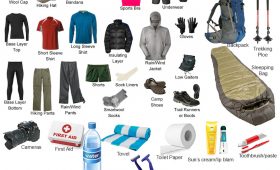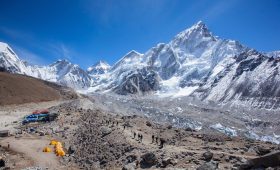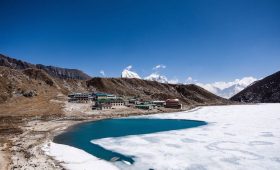Mera Peak (6,476m) is one of the world’s highest climbing peaks. It has three main peaks: Mera North (6,476m), Mera Central (6,461m), and Mera South (6,065m).
The Mera Peak climbing takes you to the true summit of Mera North. On clear days, you can see Mt. Everest, Lhotse, Makalu, Kanchenjunga, and Cho Oyu from Mera Peak.
The climb to Mera Peak is a great introduction to mountain climbing. It requires some basic climbing skills on the last part of the expedition. However, it is technically less difficult than Island Peak Climbing.
What are the Mera Peak Climbing Cost Factors?
- Duration of your expedition and routes you choose
- Meals and accommodation along the route
- Permits and mode of transportations you use to reach to the Everest region
- Field staff who go with you along the route
- Field staff’s equipment and gears important for climbing
Let us help you in making an informed decision about your estimated budget for the Mera Peak climbing.
Duration of the Trip
The duration of the expedition is very important as it greatly influences the real cost of your Mera Peak climbing.
The shortest route takes 15 to 16 days. However, it is not proposed for beginner hikers or people not used to high altitude regions.
If you are a seasonal mountain climber looking for a new challenge, the 16-day Mera Peak climbing trip is ideal for you.
The longer route takes between 18 to 24 days. The 19-day Mera Peak climbing is fantastic because it is professionally designed for a comfortable and successful climb. It guarantees both your safety and your success.
Mera Peak Climbing Cost and Routes
Route 1: You take a flight to Lukla, Nepal. After that, you will trek through Zatrwa La Pass (4610m) to Tagnag and then to Mera Base Camp. This is one of the shortest routes, but it can be challenging for inexperienced climbers.
The average cost of this route is around $2000.
Route 2: You fly to Lukla. From here, you can take the Everest Base Camp trek route all the way to Namche Bazaar. And separate to Mera Base Camp from Namche Bazaar. From there to the summit and return.
The average cost of this route is around $2300. Tea houses and lodges on the Everest Base Camp trek route are slightly more expensive.
Route 3: You fly to Lukla. From here, you trek through the remote and lovely region to Hinku Valley. And you can trek to Tagnag to Mera Base Camp, and then back down the same trail. This one of the most suggested trails to Mera Peak. It gives you enough time to acclimatize and is a popular route.
The average cost for this route is around $2850. The cost is high due to the length of this route, which takes between 18 to 22 days on average.
Tip: Instead of flying from Lukla to Kathmandu, you can take the Jeep to Kathmandu from Thamdanda.
Jiri can be the starting point for your actual journey. Once in Jiri, you will trek through the Solukhumbu region to reach Lukla. This helps to gradually acclimatizing to the altitude of Lukla. You can take one of these three routes from Lukla. This way, you can reduce the cost of your Lukla flight.
What are the Mera Peak Climbing Permit Cost?
Once you’ve decided on a route, you’ll need one or more of these permits. Sagarmatha National park entrance permit fee is as follows:
- SAARC nationals: Nrs. 16650, approximately US $15
- Other nationals: Rs. 3390, approximately US $30
Mera Peak permit cost as follows:
- March to May: $250
- September to November: $125
- December to February: $70
- June to August: $70
Tips: You do not have to worry about what permits to get. Allow us to handle your permits and legal preparations.
Climbing Mera Peak requires all trekkers to use a trekking agency. This is in accordance with government rules while climbing mountain peaks in Nepal.
Mera Peak Climbing Itinerary
| Days | Itinerary | Altitude | Time | |
|---|---|---|---|---|
| Day 1 | Arrive in Kathmandu | 1400m | ||
| Day 2 | Kathmandu: trip preparation | 1400m | ||
| Day 3 | Fly to Lukla, trek to Paiya (Chutok) | 2800m | 5 - 6 hours | |
| Day 4 | Paiya to Panggom | 2846m | 5 - 6 hours | |
| Day 5 | Panggom to Ningsow | 2863m | 4 - 5 hours | |
| Day 6 | Ningsow to Chhatra Khola | 2800m | 7 - 8 hours | |
| Day 7 | Chhatra Khola to Kothe | 3691m | 6 - 7 hours | |
| Day 8 | Kothe to Thaknak | 4358m | 3 - 4 hours | |
| Day 9 | Thaknak to Khare | 5045m | 3 hours | |
| Day 10 | Acclimatization and pre-climb training | 5045m | ||
| Day 11 | Khare to Mera High Camp | 5780m | ||
| Day 12 | Mera High Camp to Summit and back to Khare 6,461m | 6461m | ||
| Day 13 | Reserve day for Contingency | 5045m | ||
| Day 14 | Khare to Kothe | 3691m | 4 - 5 hours | |
| Day 15 | Kothe to Thuli Kharka | 4300m | 5 - 6 hours | |
| Day 16 | Thuli Kharla to Lukla via Zatrwa La pass | 4600m | 6 - 7 hours | |
| Day 17 | Fly to Kathmandu | 1400m | ||
| Day 18 | Free day / Fly to home |
Mera Peak Climbing Accommodation Costs
There are multiple choices for accommodation in Kathmandu. The cost of your stay here can range between $15 to $400 per night. This range is due to the presence of basic lodges to five-star hotels. The cost of accommodation can vary depending on your preferences.
From Lukla to Khare, your choice of accommodations is limited. You will either stay in shared rooms with two beds or in dorm rooms. These rooms cost between $2 to $6 per night.
On luxury trip to Mera Peak, the accommodation cost is considerably higher. You have your own room with the same basic facilities: a bed, a clean mattress, a sheet and a blanket.
You will spend the night at Mera Base Camp before moving on to Mera High Camp the next day. You’ll spend the night at Mera High Camp before attempting to summit Mera Peak with the break dawn.
You can rent or purchase a tent. A good, durable and trek-suitable tent can cost between $150 to $250. This range is due to the quality, brand, durability and the number of people it fits.
Meals and Drinks Cost
Just like accommodation, your choice for meals and drinks are limitless in Kathmandu. Hence, the cost associated with it depends on the preference. A simple meal can cost anywhere from $2 to $30.
From Lukla to Khare, your options for meals and drinks are slightly moderate. Almost all of the guest houses, restaurants, and cafes on the routes have some basic menu.
The menu can includes dal-bhat (steamed rice, lentils, and seasonal vegetables), roti (flatbread), noodles, fried rice, momo (dumplings), and so on. Prices for these can range from $3 to $7 per plate.
In Namche Bazaar, there are good cafes that serves good, fresh bread and pastries.
From Khare to Mera Base Camp and return, your choices for drinks and meals are limited to the things that’ve been bought and carried on the back of the porters. Our cook will prepare and serve you hygienic food.
Mode of Transportations
Air travel is the only direct route from Kathmandu to Lukla. The cost of a flight ticket varies depending on availability, season and early booking. The price ranges from USD $160 to $185.
You can also take a bus/jeep from Kathmandu to Jiri. You can trek from Jiri to Lukla, which takes about 6 days. Bus transportation from Kathmandu to Jiri cost $5 to $7.
Tip: If you don’t want to end up standing in long lines, you should buy your bus tickets a day in advance. The bus ride takes 8 to 9 hours, while the flight takes 25 to 30 minutes. Each has its own unique adventures and excitements.
Field Staff
Mera Peak is a wonderful and challenging off-road trip. You can summit the peak comfortably and successfully with the support of your field staff.
Guide: A trained highly skilled and experienced guide can help enhance your trip experience. As this Mera Peak trek takes you through unmarked trails, a guide can help ensure your safety and trekking routes.
A guide can provide information on the surrounding mountain ranges landscapes, flora and fauna.
Mera Peak climbing guide: A climbing guide is experienced in climbing and summiting mountain peaks. A climbing guide will help you in the final push of the Mera Peak summit.
A climbing guide helps on the technical aspects of your expedition. They are your basic mountaineering training instructors as well.
The guide, an assistant guide, porter, and a climbing guide will help you with the climb. They can also help you with ropes and ladders if you need them while climbing or descending the peak.
An assistant guide is generally someone on their way to becoming a fully licensed guide. He will have less experience than a guide but will help improve your overall trip experience.
He will assist the guide and help set up camp. An assistant guide is useful for large groups because a single guide may not be able to meet all of the individual needs of each member of the group.
Porter: A porter will help minimize your load. Depending on the size of the group, there may be more than one porter. A porter will carry all of your expedition gears and supplies that you will not require on the day. Each porter will carry around 25kg of weight.
You’ll be carrying your daypack, which should have all the things you’ll need for the day.
Tip: The size of the group will also determines your overall on-field staff expense. Some of the costs for field staff can be shared.
Miscellaneous expenses
Tipping: Most sectors related to hospitality and tourism do expect a tip for a service well done. If you are happy with the services you have received, you can express your appreciation to the field staff as well as the guesthouses, restaurants, and cafes.
Fees for charging electronic gadgets: The tea houses along the trails could charge you a fee to charge your electronic devices. The cost per hour can range between $2 to $4. This range depends on the availability of sockets, electricity, the season, and negotiation skills.
Hot showers: On the trail, the tea houses also charge for hot showers. This is not included in the cost of your accommodation. The hot showers cost between $2 to $6. The charges depend on the season and negotiation skills.
Travel Insurance for Mera Peak Climbing
It is strongly recommended to get travel insurance that covers treks and high altitude climbs like Mera Peak climbing. This is for your own safety, and it is also required for many professional and reputable trekking agencies to accept you.
A good travel insurance policy for your Mera Peak climbing trip can range between $125 to $280.
The cost and conditions of travel insurance vary. The basic rule for the average cost of travel insurance is 4% – 10% of your total, non-refundable travel cost.
If you have travel insurance, make sure it covers high altitude climbs and emergency helicopter evacuations in foreign countries like Nepal. It is also recommended that you get travel insurance from your home country.
You may also like:
Things to Know
- Carry enough cash to cover all of your expenses on the trek. The ATMs on the trails are not available (except Lukla). Most shops and tea houses do not accept credit cards.
- Have some extra cash on hand to buy souvenirs along the way. The variety of local handicrafts available on the trail may surprise you.
- Along the trails, you will pass by some ancient temples, monasteries, and stupas. You can donate here if you want.
- Remember to check what is included in your trip package.
- Before confirming, compare the prices of different trekking agencies’ trip packages. This allows you to make an informed decision.
- If possible, get to know your field staff before your trip. This way, you can ensure that they are qualified and licensed. You can also start to getting familiar with them.
Final Say
Climbing Mera Peak is a fantastic and exciting high-altitude adventure. It is an ideal introduction to Himalayan peak climbing in the world.
During May, you can meet professional mountaineers and summit climbers on the Mera peak trails. It’s wonderful to enjoy their vibe and energetic atmosphere.
The cost of any trip including Mera Peak climbing cost depends on a number of things. You can choose a trip package that meets your needs and budget.
Some of the factors can be changed to meet your specific needs. Feel free to get in touch for any information for this or anything else related to trips to Nepal, Bhutan, Tibet.
Do you have any question about trip to Nepal?
Tell us about your trip to Nepal and what you expect from it. We will answer your questions in 24 hours and help you design a trip with a comfortable itinerary to best meet your needs.





